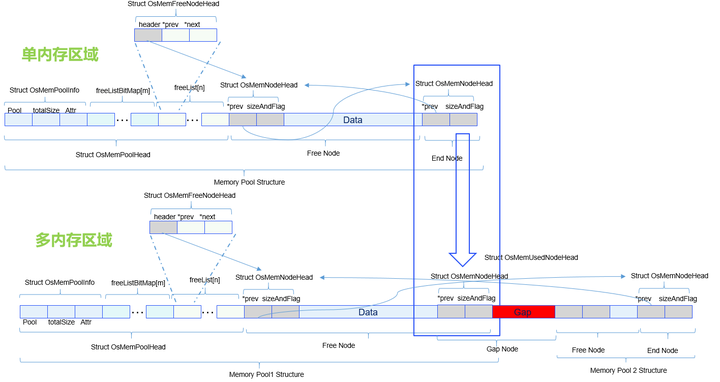摘要:鸿蒙轻内核M核新增支持了多段非连续性内存区域,把多个非连续性内存逻辑上合一,用户不感知底层的不同内存块。
本文分享自华为云社区《鸿蒙轻内核M核源码分析系列九 动态内存Dynamic Memory 补充》,作者:zhushy。
一些芯片片内RAM大小无法满足要求,需要使用片外物理内存进行扩充。对于多段非连续性内存,需要内存管理模块统一管理,应用使用内存接口时不需要关注内存分配属于哪块物理内存,不感知多块内存。
多段非连续性内存如下图所示:

鸿蒙轻内核M核新增支持了多段非连续性内存区域,把多个非连续性内存逻辑上合一,用户不感知底层的不同内存块。本文来分析下动态内存模块的支持多段非连续内存的源码,帮助读者掌握其使用。本文中所涉及的源码,以OpenHarmony LiteOS-M内核为例,均可以在开源站点https://gitee.com/openharmony/kernel_liteos_m 获取。接下来,我们看下新增的结构体、宏和对外接口的源代码。
1、结构体定义和常用宏定义
在文件kernel/include/los_memory.h中新增了结构体LosMemRegion用于维护多个非连续的内存区域,包含各个内存区域的开始地址和大小。如下:
typedef struct { VOID *startAddress; /* 内存区域的开始地址 */ UINT32 length; /* 内存区域的长度 */ } LosMemRegion;
需要注意这个结构体的定义需要开启宏LOSCFG_MEM_MUL_REGIONS的情况下才生效,这个宏也是支持非连续内存区域的配置宏,定义在文件kernel/include/los_config.h中。
我们继续看下新增的几个宏函数,定义在文件kernel/src/mm/los_memory.c,代码下下文:
注释讲的比较明白,当开启LOSCFG_MEM_MUL_REGIONS支持非连续内存特性时,会把两个不连续内存区域之间的间隔Gap区域标记为虚拟的已使用内存节点。这个节点当然不能被释放,在内存调测特性中也不能被统计。因为我们只是把它视为已使用内存节点,但其实不是。在动态内存算法中每个内存节点都维护一个指向前序节点的指针,对于虚拟已使用节点,我们把该指针设置为魔术字,来标记它是个内存区域的间隔部分。
⑴处定义了一个魔术字OS_MEM_GAP_NODE_MAGIC,用于表示两个不连续内存区域之前的间隔Gap区域。⑵和⑶处定义2个宏,分别用于设置魔术字,验证魔术字。
#if (LOSCFG_MEM_MUL_REGIONS == 1) /** * When LOSCFG_MEM_MUL_REGIONS is enabled to support multiple non-continuous memory regions, the gap between two memory regions * is marked as a used OsMemNodeHead node. The gap node could not be freed, and would also be skipped in some DFX functions. The * 'ptr.prev' pointer of this node is set to OS_MEM_GAP_NODE_MAGIC to identify that this is a gap node. */ ⑴ #define OS_MEM_GAP_NODE_MAGIC 0xDCBAABCD ⑵ #define OS_MEM_MARK_GAP_NODE(node) (((struct OsMemNodeHead *)(node))->ptr.prev = (struct OsMemNodeHead *)OS_MEM_GAP_NODE_MAGIC) ⑶ #define OS_MEM_IS_GAP_NODE(node) (((struct OsMemNodeHead *)(node))->ptr.prev == (struct OsMemNodeHead *)OS_MEM_GAP_NODE_MAGIC) #else ⑵ #define OS_MEM_MARK_GAP_NODE(node) ⑶ #define OS_MEM_IS_GAP_NODE(node) FALSE #endif
2、动态内存常用操作
本节我们一起分析下非连续性内存的实现算法,及接口实现代码。首先通过示意图了解下算法:

集合示意图,我们了解下非连续性内存合并为一个内存池的步骤:
- 1、把多段内存区域的第一块内存区域调用LOS_MemInit进行初始化
- 2、获取下一个内存区域的开始地址和长度,计算该内存区域和上一块内存区域的间隔大小gapSize。
- 3、把内存块间隔部分视为虚拟的已使用节点,使用上一内存块的尾节点,设置其大小为gapSize+ OS_MEM_NODE_HEAD_SIZE。
- 4、把当前内存区域划分为一个空闲内存块和一个尾节点,把空闲内存块插入到空闲链表。并设置各个节点的前后链接关系。
- 5、有更多的非连续内存块,重复上述步骤2-4。
2.1 新增接口LOS_MemRegionsAdd
新增的接口的接口说明文档见下文,注释比较详细,总结如下:
- LOSCFG_MEM_MUL_REGIONS=0:
不支持多段非连续内存,相关代码不使能。
- LOSCFG_MEM_MUL_REGIONS=1:
支持多段非连续内存,相关代码使能。用户配置多段内存区域,调用接口
LOS_MemRegionsAdd(VOID *pool, const LosMemRegion * const multipleMemRegions)进行内存池合一:
- 如果pool为空,则合并到主内存堆m_aucSysMem0。
- 如果不为空,则初始化一个新的内存池,合并多内存区域为一个从堆。
/** * @ingroup los_memory * @brief Initialize multiple non-continuous memory regions. * * @par Description: * <ul> * <li>This API is used to initialize multiple non-continuous memory regions. If the starting address of a pool is specified, * the memory regions will be linked to the pool as free nodes. Otherwise, the first memory region will be initialized as a * new pool, and the rest regions will be linked as free nodes to the new pool.</li> * </ul> * * @attention * <ul> * <li>If the starting address of a memory pool is specified, the start address of the non-continuous memory regions should be * greater than the end address of the memory pool.</li> * <li>The multiple non-continuous memory regions shouldn't conflict with each other.</li> * </ul> * * @param pool [IN] The memory pool address. If NULL is specified, the start address of first memory region will be * initialized as the memory pool address. If not NULL, it should be a valid address of a memory pool. * @param memRegions [IN] The LosMemRegion array that contains multiple non-continuous memory regions. The start address * of the memory regions are placed in ascending order. * @param memRegionCount [IN] The count of non-continuous memory regions, and it should be the length of the LosMemRegion array. * * @retval #LOS_NOK The multiple non-continuous memory regions fails to be initialized. * @retval #LOS_OK The multiple non-continuous memory regions is initialized successfully. * @par Dependency: * <ul> * <li>los_memory.h: the header file that contains the API declaration.</li> * </ul> * @see None. */ extern UINT32 LOS_MemRegionsAdd(VOID *pool, const LosMemRegion * const memRegions, UINT32 memRegionCount);
2.2 新增接口LOS_MemRegionsAdd实现
结合上文示意图,加上注释,实现比较清晰,直接阅读下代码即可。
#if (LOSCFG_MEM_MUL_REGIONS == 1) STATIC INLINE UINT32 OsMemMulRegionsParamCheck(VOID *pool, const LosMemRegion * const memRegions, UINT32 memRegionCount) { const LosMemRegion *memRegion = NULL; VOID *lastStartAddress = NULL; VOID *curStartAddress = NULL; UINT32 lastLength; UINT32 curLength; UINT32 regionCount; if ((pool != NULL) && (((struct OsMemPoolHead *)pool)->info.pool != pool)) { PRINT_ERR("wrong mem pool addr: %p, func: %s, line: %d ", pool, __FUNCTION__, __LINE__); return LOS_NOK; } if (pool != NULL) { lastStartAddress = pool; lastLength = ((struct OsMemPoolHead *)pool)->info.totalSize; } memRegion = memRegions; regionCount = 0; while (regionCount < memRegionCount) { curStartAddress = memRegion->startAddress; curLength = memRegion->length; if ((curStartAddress == NULL) || (curLength == 0)) { PRINT_ERR("Memory address or length configured wrongly:address:0x%x, the length:0x%x ", (UINTPTR)curStartAddress, curLength); return LOS_NOK; } if (((UINTPTR)curStartAddress & (OS_MEM_ALIGN_SIZE - 1)) || (curLength & (OS_MEM_ALIGN_SIZE - 1))) { PRINT_ERR("Memory address or length configured not aligned:address:0x%x, the length:0x%x, alignsize:%d ", (UINTPTR)curStartAddress, curLength, OS_MEM_ALIGN_SIZE); return LOS_NOK; } if ((lastStartAddress != NULL) && (((UINT8 *)lastStartAddress + lastLength) >= (UINT8 *)curStartAddress)) { PRINT_ERR("Memory regions overlapped, the last start address:0x%x, the length:0x%x, the current start address:0x%x ", (UINTPTR)lastStartAddress, lastLength, (UINTPTR)curStartAddress); return LOS_NOK; } memRegion++; regionCount++; lastStartAddress = curStartAddress; lastLength = curLength; } return LOS_OK; } STATIC INLINE VOID OsMemMulRegionsLink(struct OsMemPoolHead *poolHead, VOID *lastStartAddress, UINT32 lastLength, struct OsMemNodeHead *lastEndNode, const LosMemRegion *memRegion) { UINT32 curLength; UINT32 gapSize; struct OsMemNodeHead *curEndNode = NULL; struct OsMemNodeHead *curFreeNode = NULL; VOID *curStartAddress = NULL; curStartAddress = memRegion->startAddress; curLength = memRegion->length; // mark the gap between two regions as one used node gapSize = (UINT8 *)(curStartAddress) - ((UINT8 *)(lastStartAddress) + lastLength); lastEndNode->sizeAndFlag = gapSize + OS_MEM_NODE_HEAD_SIZE; OS_MEM_SET_MAGIC(lastEndNode); OS_MEM_NODE_SET_USED_FLAG(lastEndNode->sizeAndFlag); // mark the gap node with magic number OS_MEM_MARK_GAP_NODE(lastEndNode); poolHead->info.totalSize += (curLength + gapSize); poolHead->info.totalGapSize += gapSize; curFreeNode = (struct OsMemNodeHead *)curStartAddress; curFreeNode->sizeAndFlag = curLength - OS_MEM_NODE_HEAD_SIZE; curFreeNode->ptr.prev = lastEndNode; OS_MEM_SET_MAGIC(curFreeNode); OsMemFreeNodeAdd(poolHead, (struct OsMemFreeNodeHead *)curFreeNode); curEndNode = OS_MEM_END_NODE(curStartAddress, curLength); curEndNode->sizeAndFlag = 0; curEndNode->ptr.prev = curFreeNode; OS_MEM_SET_MAGIC(curEndNode); OS_MEM_NODE_SET_USED_FLAG(curEndNode->sizeAndFlag); #if (LOSCFG_MEM_WATERLINE == 1) poolHead->info.curUsedSize += OS_MEM_NODE_HEAD_SIZE; poolHead->info.waterLine = poolHead->info.curUsedSize; #endif } UINT32 LOS_MemRegionsAdd(VOID *pool, const LosMemRegion *const memRegions, UINT32 memRegionCount) { UINT32 ret; UINT32 lastLength; UINT32 curLength; UINT32 regionCount; struct OsMemPoolHead *poolHead = NULL; struct OsMemNodeHead *lastEndNode = NULL; struct OsMemNodeHead *firstFreeNode = NULL; const LosMemRegion *memRegion = NULL; VOID *lastStartAddress = NULL; VOID *curStartAddress = NULL; ret = OsMemMulRegionsParamCheck(pool, memRegions, memRegionCount); if (ret != LOS_OK) { return ret; } memRegion = memRegions; regionCount = 0; if (pool != NULL) { // add the memory regions to the specified memory pool poolHead = (struct OsMemPoolHead *)pool; lastStartAddress = pool; lastLength = poolHead->info.totalSize; } else { // initialize the memory pool with the first memory region lastStartAddress = memRegion->startAddress; lastLength = memRegion->length; poolHead = (struct OsMemPoolHead *)lastStartAddress; ret = LOS_MemInit(lastStartAddress, lastLength); if (ret != LOS_OK) { return ret; } memRegion++; regionCount++; } firstFreeNode = OS_MEM_FIRST_NODE(lastStartAddress); lastEndNode = OS_MEM_END_NODE(lastStartAddress, lastLength); while (regionCount < memRegionCount) { // traverse the rest memory regions, and initialize them as free nodes and link together curStartAddress = memRegion->startAddress; curLength = memRegion->length; OsMemMulRegionsLink(poolHead, lastStartAddress, lastLength, lastEndNode, memRegion); lastStartAddress = curStartAddress; lastLength = curLength; lastEndNode = OS_MEM_END_NODE(curStartAddress, curLength); memRegion++; regionCount++; } firstFreeNode->ptr.prev = lastEndNode; return ret; } #endif
小结
本文带领大家一起剖析了鸿蒙轻内核M核的动态内存如何支持多段非连续性内存,包含结构体、运作示意图、新增接口等等。感谢阅读,如有任何问题、建议,都可以留言评论,谢谢。
更多学习内容,请点击关注IoT物联网社区,添加华为云IoT小助手微信号(hwc-iot),获取更多资讯